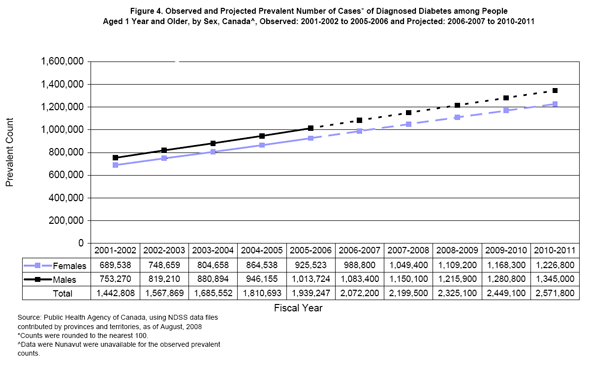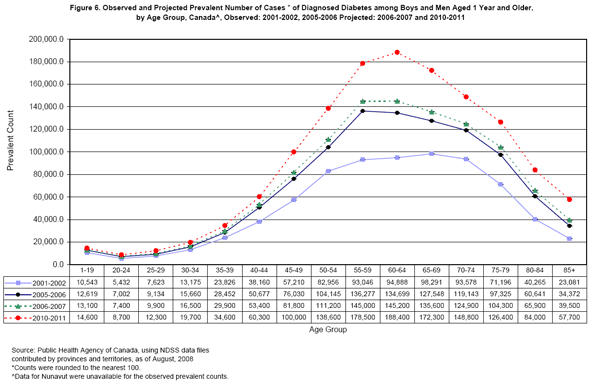Common menu bar links
Institutional links
Diseases & Conditions
Health & Safety
Research & Statistics
Agency Information
Search Box
E-mail this page
Report from the National Diabetes Surveillance System: Diabetes in Canada, 2008
[Previous] [Table of Contents] [next]
Forecasted Prevalence5,7
For People Aged 1 and Older:
- By 2011, the number of Canadians with diagnosed diabetes is expected to be about 2.6 million - an average annual percent increase of almost 7% and an increase by about 33% since 2006. (Figure 4)
- By 2010-2011, one in three (35%) of people with diabetes will be in the 50 to 64 year old age range, due to the increased risk of developing diabetes over age 40, the entrance of the baby boom generation into the older age groups, and the rise in the prevalence of obesity. (Figures 5 and 6)
Figure 4. Observed and Projected Prevalent Number of Cases* of Diagnosed Diabetes among People Aged 1 Year and Older, by Sex, Canada^, Observed: 2001-2002 to 2005-2006 and Projected: 2006-2007 to 2010-2011

Figure 5. Observed and Projected Prevalent Number of Cases* of Diagnosed Diabetes among Girls and Women Aged 1 Year and Older, by Age Group, Canada^, Observed: 2001-2002, 2005-2006 Projected: 2006-2007 and 2010-2011

Figure 6. Observed and Projected Prevalent Number of Cases * of Diagnosed Diabetes among Boys and Men Aged 1 Year and Older, by Age Group, Canada^, Observed: 2001-2002, 2005-2006 Projected: 2006-2007 and 2010-2011

- The proportion of a individuals that are affected by diagnosed diabetes at a given point in time.
- For a more detailed explanation of the age-standardization technique, refer to the methods for this report on the NDSS website: www.ndss.gc.ca.
- These statistics were calculated using estimates for future populations from Statistics Canada and the assumption that both future NDSS incidence and mortality rates remain constant.
[Previous] [Table of Contents] [next]
